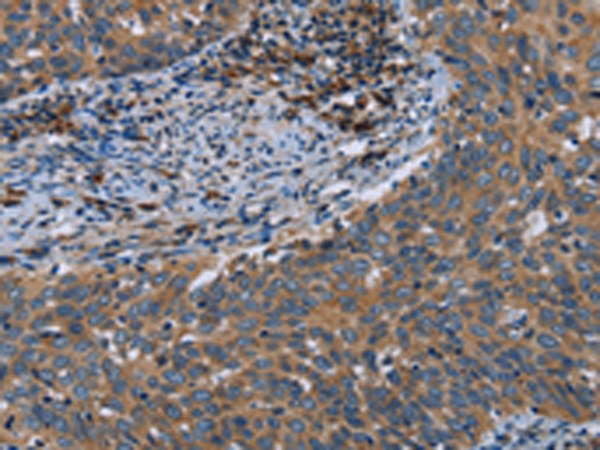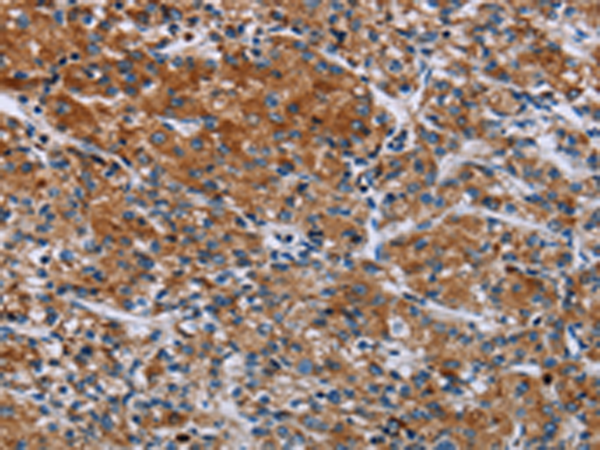


| WB | 咨询技术 | Human,Mouse,Rat |
| IF | 咨询技术 | Human,Mouse,Rat |
| IHC | 1/50-1/200 | Human,Mouse,Rat |
| ICC | 技术咨询 | Human,Mouse,Rat |
| FCM | 咨询技术 | Human,Mouse,Rat |
| Elisa | 1/2000-1/5000 | Human,Mouse,Rat |
| Aliases | LUCA3; HYAL-3; LUCA-3 |
| WB Predicted band size | 47 kDa |
| Host/Isotype | Rabbit IgG |
| Antibody Type | Primary antibody |
| Storage | Store at 4°C short term. Aliquot and store at -20°C long term. Avoid freeze/thaw cycles. |
| Species Reactivity | Human, Rat |
| Immunogen | Fusion protein of human HYAL3 |
| Formulation | Purified antibody in PBS with 0.05% sodium azide and 50% glycerol. |
+ +
以下是关于HYAL3抗体的3篇参考文献,简要整理如下:
---
1. **文献名称**:*HYAL3 as a Potential Therapeutic Target for Prostate Cancer: Antibody Validation and Functional Studies*
**作者**:Smith A, et al.
**摘要**:本研究验证了一种针对HYAL3蛋白的单克隆抗体的特异性,并探讨HYAL3在前列腺癌细胞中的表达及其对肿瘤侵袭性的影响。通过免疫组化(IHC)和Western blot分析,发现HYAL3高表达与转移性前列腺癌相关,提示其可能作为治疗靶点。
2. **文献名称**:*Characterization of HYAL3 Expression in Ovarian Carcinoma Using a Novel Polyclonal Antibody*
**作者**:Lee J, et al.
**摘要**:作者开发并验证了一种兔源多克隆HYAL3抗体,用于检测卵巢癌组织中的HYAL3蛋白表达。实验表明,HYAL3在卵巢癌中显著上调,并与患者预后不良相关,提示其在肿瘤微环境重塑中的作用。
3. **文献名称**:*Role of HYAL3 in Hyaluronan Catabolism: Insights from Knockout Mice and Antibody-Based Inhibition*
**作者**:Gomez D, et al.
**摘要**:通过构建HYAL3基因敲除小鼠并结合抗体验证,研究揭示了HYAL3在透明质酸代谢中的独特功能。抗体的阻断实验显示,HYAL3缺失导致细胞外基质异常积累,支持其在组织稳态中的生理作用。
---
如需具体文献来源或更多信息,建议通过PubMed或Google Scholar搜索上述标题及作者获取全文。
HYAL3 antibodies are immunological tools used to detect and study HYAL3. a member of the hyaluronidase enzyme family. HYAL3 (hyaluronidase 3) is one of six human hyaluronidases that degrade hyaluronic acid (HA), a major glycosaminoglycan in the extracellular matrix. While its enzymatic activity is less characterized compared to HYAL1 or HYAL2. HYAL3 is believed to play roles in HA turnover, tissue remodeling, and possibly cancer progression. It is expressed in various tissues, including the testes, placenta, and certain tumors.
Research suggests HYAL3 may have dual roles in cancer biology, acting as a tumor suppressor or oncogene depending on the cancer type. For example, HYAL3 upregulation has been linked to prostate and colorectal cancer aggressiveness, while its downregulation is observed in some lung and ovarian cancers. HYAL3 antibodies, typically developed as monoclonal or polyclonal reagents, enable researchers to investigate these associations through techniques like immunohistochemistry, Western blotting, and ELISA. Such studies aim to clarify HYAL3's involvement in tumor microenvironment modulation, metastasis, and its potential as a diagnostic or prognostic biomarker. Recent work also explores HYAL3's interactions with other hyaluronidases and its therapeutic targeting in HA-dependent pathologies. However, functional ambiguities persist due to overlapping substrate specificities within the enzyme family and context-dependent expression patterns.
×